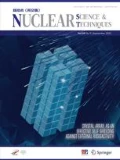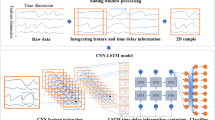Abstract
Early fault warning for nuclear power machinery is conducive to timely troubleshooting and reductions in safety risks and unnecessary costs. This paper presents a novel intelligent fault prediction method, integrated probabilistic principal component analysis (PPCA), multi-resolution wavelet analysis, Bayesian inference, and RNN model for nuclear power machinery that consider data uncertainty and chaotic time series. After denoising the source data, the Bayesian PPCA method is employed for dimensional reduction to obtain a refined data group. A recurrent neural network (RNN) prediction model is constructed, and a Bayesian statistical inference approach is developed to quantitatively assess the prediction reliability of the model. By modeling and analyzing the data collected on the steam turbine and components of a nuclear power plant, the results of the goodness of fit, mean square error distribution, and Bayesian confidence indicate that the proposed RNN model can implement early warning in the fault creep period. The accuracy and reliability of the proposed model are quantitatively verified.









Similar content being viewed by others
References
J.P. Ma, J. Jiang, Applications of fault detection and diagnosis methods in nuclear power plants: a review. Prog. Nucl. Energy 53, 255–266 (2011). https://doi.org/10.1016/j.pnucene.2010.12.001
S. Mandal, B. Santhi, S. Sridhar et al., Nuclear power plant thermocouple sensor-fault detection and classification using deep learning and generalized likelihood ratio test. IEEE Trans. Nucl. Sci. 64, 1526–1534 (2017). https://doi.org/10.1109/TNS.2017.2697919
Y.J. Gong, X.Y. Su, H. Qian et al., Research on fault diagnosis methods for the reactor coolant system of nuclear power plant based on D–S evidence theory. Ann. Nucl. Energy 112, 395–399 (2018). https://doi.org/10.1016/j.anucene.2017.10.026
D. Wu, J. Wang, S.J. Du et al., Validation of the discharge force analysis method and key influence factors study. Nucl. Tech. 43(4), 040007 (2020). https://doi.org/10.11889/j.0253-3219.2020.hjs.43.040007. (in Chinese)
W.F. Lyu, M.L. Chen, Q.Q. Huang et al., Development on calculation code CPAP for radioactive activation product of pressurized water reactor nuclear power plant. Nucl. Tech. 43(4), 040005 (2020). https://doi.org/10.11889/j.0253-3219.2020.hjs.43.040005. (in Chinese)
J.T. Mo, A multi-field coupling simulation method for rod dropping behavior based on overset mesh. Nucl. Tech. 43(5), 050605 (2020). https://doi.org/10.11889/j.0253-3219.2020.hjs.43.050605. (in Chinese)
H.Y. Xie, J.X. Li, Z.Y. Yan, et al., Research of critical reactivity control online early warning technology in nuclear power plant. In: Proceedings of the 2nd International Symposium on Software Reliability, Industrial Safety, Cyber Security and Physical Protection of Nuclear Power Plant, Aug (2017), pp. 102–108. https://doi.org/10.1007/978-981-10-7416-5_13
H. Qian, Si-Yun Lin, Miao Zheng, et al. Research on intelligent early-warning system of main pipeline in nuclear power plants based on hierarchical and multidimensional fault identification method. In: Proceedings of the International Conference on Intelligent Computing for Sustainable Energy and Environment, Sep (2017), pp. 195–205. https://doi.org/10.1007/978-981-10-6364-0_20
J.H. Min, D.W. Kim, C.Y. Park, Demonstration of the validity of the early warning in online monitoring system for nuclear power plants. Nucl. Eng. Des. 349, 56–62 (2019). https://doi.org/10.1016/j.nucengdes.2019.04.028
B.S. Peng, H. Xia, Y.K. Liu et al., Research on intelligent fault diagnosis method for nuclear power plant based on correlation analysis and deep belief network. Prog. Nucl. Energy 108, 419–427 (2018). https://doi.org/10.1016/j.pnucene.2018.06.003
Y.T. Yao, J. Wang, M. Xie, L.Q. Hu et al., A new approach for fault diagnosis with full-scope simulator based on state information imaging in nuclear power plant. Ann. Nucl. Energy 141, 107274 (2020). https://doi.org/10.1016/j.anucene.2019.107274
A.S. Qin, H. Qin, Y.R. Lv et al., Concurrent fault diagnosis based on Bayesian discriminating analysis and time series analysis with dimensionless parameters. IEEE Sens. J. 19, 2254–2265 (2019). https://doi.org/10.1109/JSEN.2018.2885377
M. Mehrjoo, M.J. Jozani, M. Pawlak, Wind turbine power curve modeling for reliable power prediction using monotonic regression. Renew. Energy 147, 214–222 (2020). https://doi.org/10.1016/j.renene.2019.08.060
S.A. Aye, P.S. Heyns, An integrated Gaussian process regression for prediction of remaining useful life of slow speed bearings based on acoustic emission. Mech. Syst. Signal Process. 84, 485–498 (2017). https://doi.org/10.1016/j.ymssp.2016.07.039
Y.C. Jiang, S. Yin, Recursive total principle component regression based fault detection and its application to vehicular cyber-physical systems. IEEE Trans. Ind. Inform. 14, 1415–1423 (2018). https://doi.org/10.1109/TII.2017.2752709
T.Y. Gao, S. Yin, J.B. Qiu et al., A partial least squares aided intelligent model predictive control approach. IEEE Trans. Syst. Man. Cybern-Syst. 48, 2013–2021 (2018). https://doi.org/10.1109/TSMC.2017.2723017
J. Herp, M.H. Ramezani, M. Bach-Andersen et al., Bayesian state prediction of wind turbine bearing failure. Renew. Energy 116, 164–172 (2018). https://doi.org/10.1016/j.renene.2017.02.069
J.C. Li, Y.P. Cao, Y.L. Ying et al., A rolling element bearing fault diagnosis approach based on multifractal theory and gray relation theory. PLoS ONE 11, e0167587 (2016). https://doi.org/10.1371/journal.pone.0167587
J. Liu, J.F. Liu, D.R. Yu et al., Fault detection for gas turbine hot components based on a convolutional neural network. Energies 11, 2149 (2018). https://doi.org/10.3390/en11082149
Z.M. Liu, I.A. Karimi, Gas turbine performance prediction via machine learning. Energy 192, 116627 (2020). https://doi.org/10.1016/j.energy.2019.116627
M. He, D. He, Deep Learning based approach for bearing fault diagnosis. IEEE Trans. Ind. Appl. 53, 3057–3065 (2017). https://doi.org/10.1109/TIA.2017.2661250
H.S. Zhao, H.H. Liu, W.J. Hu et al., Anomaly detection and fault analysis of wind turbine components based on deep learning network. Renew. Energy 127, 825–834 (2018). https://doi.org/10.1109/TIA.2017.2661250
L. Wen, L. Gao, X.Y. Li, A new deep transfer learning based on sparse auto-encoder for fault diagnosis. IEEE Trans. Syst. Man Cybern-Syst. 49, 136–144 (2019). https://doi.org/10.1109/TSMC.2017.2754287
H. Liu, J.Z. Zhou, Y. Zheng et al., Fault diagnosis of rolling bearings with recurrent neural network-based autoencoders. ISA Trans. 77, 167–178 (2018). https://doi.org/10.1016/j.isatra.2018.04.005
H. Shahnazari, Fault diagnosis of nonlinear systems using recurrent neural networks. Chem. Eng. Res. Des. 153, 233–245 (2020). https://doi.org/10.1016/j.cherd.2019.09.026
J.N. Wang, Y. Dou, Z.H. Wang et al., Multi-fault diagnosis method for wind power generation system based on recurrent neural network. Proc. Inst. Mech. Eng. A-J Pow. 233, 604–615 (2019). https://doi.org/10.1177/0957650919844065
A.S. Palau, M.H. Dhada, K. Bakliwal et al., An industrial multi agent system for real-time distributed collaborative prognostics. Eng. Appl. Artif. Intell. 85, 590–606 (2019). https://doi.org/10.1016/j.engappai.2019.07.013
J.J. Wang, P.L. Fu, L.B. Zhang et al., Multilevel information fusion for induction motor fault diagnosis. IEEE-ASME Trans. Mech. 24, 2139–2150 (2019). https://doi.org/10.1109/TMECH.2019.2928967
W. Li, M.J. Peng, Y.K. Liu et al., Fault detection, identification and reconstruction of sensors in nuclear power plant with optimized PCA method. Ann. Nucl. Energy 113, 105–117 (2018). https://doi.org/10.1016/j.anucene.2017.11.009
M.R. Prusty, T. Jayanthi, J. Chakraborty et al., Feasibility of ANFIS towards multiclass event classification in PFBR considering dimensionality reduction using PCA. Ann. Nucl. Energy 99, 311–320 (2017). https://doi.org/10.1016/j.anucene.2016.09.015
G.H. Wu, J.J. Tong, L.G. Zhang et al., Framework for fault diagnosis with multi-source sensor nodes in nuclear power plants based on a Bayesian network. Ann. Nucl. Energy 122, 297–308 (2018). https://doi.org/10.1016/j.anucene.2018.08.050
R. Sharifi, R. Langari, Nonlinear sensor fault diagnosis using mixture of probabilistic PCA models. Mech. Syst. Signal Process. 85, 638–650 (2017). https://doi.org/10.1016/j.ymssp.2016.08.028
J.W. Xiang, Y.T. Zhong, H.F. Gao, Rolling element bearing fault detection using PPCA and spectral kurtosis. Measurement 75, 180–191 (2015). https://doi.org/10.1016/j.measurement.2015.07.045
M.E. Tipping, C.M. Bishop, Mixtures of probabilistic principal component analyzers. Neural Comput. 11, 443–482 (1999). https://doi.org/10.1162/089976699300016728
J.T. Liu, C.H. Wu, J.W. Wang, Gated recurrent units based neural network for time heterogeneous feedback recommendation. Inform. Sci. 423, 50–65 (2018). https://doi.org/10.1016/j.ins.2017.09.048
D. You, X. Shen, Y. Zhu et al., A quantitative validation method of kriging metamodel for injection mechanism based on Bayesian statistical inference. Metals 9, 493 (2019). https://doi.org/10.3390/met9050493
B. Cai, X. Kong, Y. Liu et al., Application of Bayesian networks in reliability evaluation. IEEE Trans. Ind. Inform. 15, 2146–2157 (2019). https://doi.org/10.1109/TII.2018.2858281
W.J. Cui, B. Cao, Y.X. Chen, Uncertainty analysis of Gaussian plume model based on Bayesian MCMC method. Nucl. Tech. 43(4), 040009 (2020). https://doi.org/10.11889/j.0253-3219.2020.hjs.43.040009. (in Chinese)
Author information
Authors and Affiliations
Corresponding authors
Additional information
This work was supported by the National Natural Science Foundation of China (No. 51875209), the Guangdong Basic and Applied Basic Research Foundation (No. 2019B1515120060), and the Open Funds of State Key Laboratory of Nuclear Power Safety Monitoring Technology and Equipment.
Rights and permissions
About this article
Cite this article
Ling, J., Liu, GJ., Li, JL. et al. Fault prediction method for nuclear power machinery based on Bayesian PPCA recurrent neural network model. NUCL SCI TECH 31, 75 (2020). https://doi.org/10.1007/s41365-020-00792-9
Received:
Revised:
Accepted:
Published:
DOI: https://doi.org/10.1007/s41365-020-00792-9




